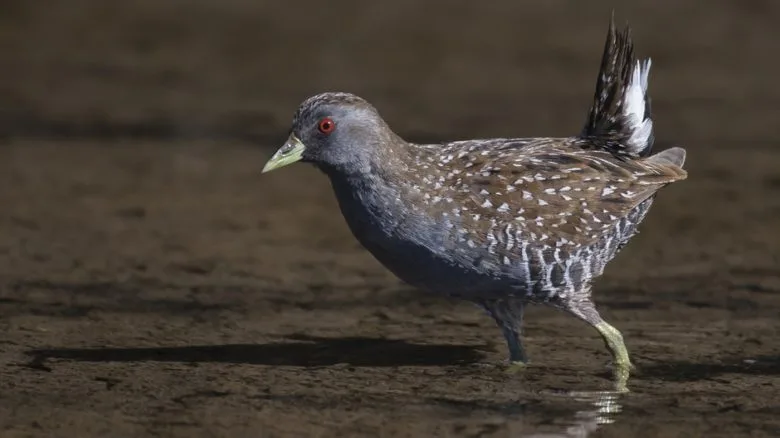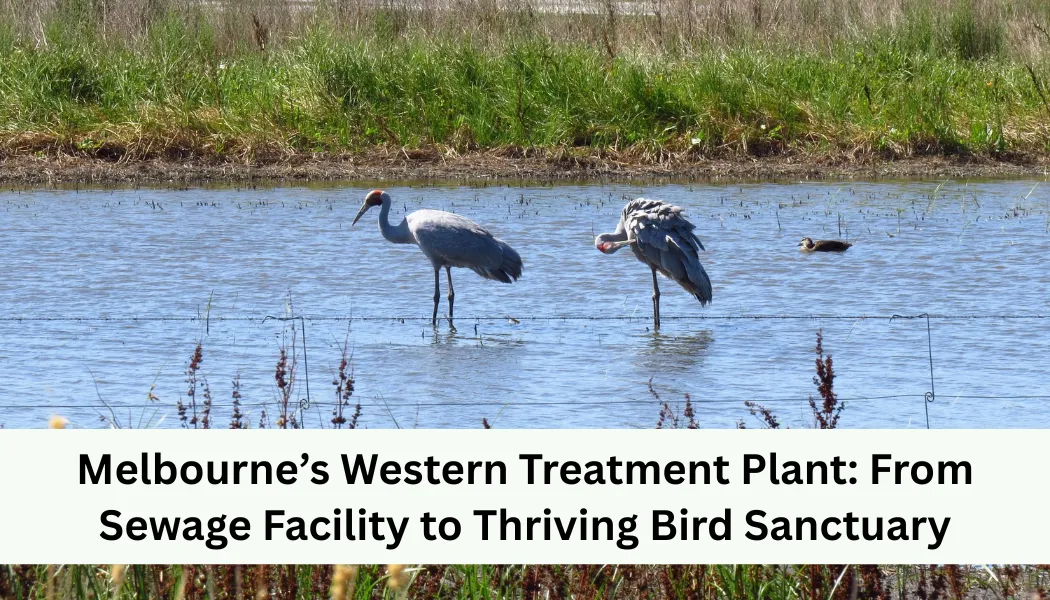In an unexpected environmental twist, Melbourne’s Western Treatment Plant—one of Australia’s primary sewage treatment facilities—has transformed into a thriving sanctuary for wildlife, particularly birds. Covering over 105 square kilometers near Werribee, this site now hosts more than 300 bird species, including critically endangered and migratory birds.
This transformation demonstrates how human-managed landscapes can play a pivotal role in biodiversity conservation, turning an industrial site into an ecological treasure. From nutrient-rich lagoons to saltmarshes, mudflats, and grasslands, the plant’s diverse habitats have created a perfect haven for avian life.
The Western Treatment Plant now serves as an example of how sustainable management practices can benefit both human infrastructure and wildlife, offering insights for conservation projects globally.
Table of contents
From Sewage Processing to Wildlife Sanctuary
Historical Background
The Western Treatment Plant was established in 1892, originally designed to process Melbourne’s sewage. Its primary function was, and continues to be, the treatment of wastewater, ensuring public health and environmental safety. Over the decades, it evolved technologically, incorporating aerated lagoons, wetlands, and recycling processes.
However, the site’s vast lagoons and open landscapes naturally attracted wildlife. Nutrient-rich waters supported dense populations of aquatic plants and invertebrates, forming an ideal food source for various bird species. As a result, even before formal recognition, the plant began gaining attention from ornithologists and birdwatchers alike.
Ecological Transformation
The facility’s management adapted to the growing ecological significance of the site. By carefully regulating water levels, vegetation, and habitat structures, Melbourne Water ensured that the plant could continue its sewage treatment function while providing optimal conditions for wildlife.
Today, the plant’s lagoons, wetlands, and grasslands provide a variety of microhabitats for birds. These include:
- Saltmarshes: Hosting waders and shorebirds.
- Mudflats: Feeding grounds for migratory birds like sandpipers and plovers.
- Open lagoons: Nesting and foraging grounds for ducks, swans, and cormorants.
- Grasslands: Roosting sites for cranes and herons.
This dual-use model demonstrates that infrastructure and biodiversity conservation can coexist harmoniously when managed with foresight and ecological understanding.
Bird Diversity at the Western Treatment Plant
The Western Treatment Plant has become a critical site for resident, migratory, and endangered bird species. Ornithologists and bird enthusiasts have recorded over 300 species, making it one of the most important bird habitats in Victoria and Australia as a whole.
Endangered and Rare Species
Some of the rare and endangered species observed at the plant include:
- Orange-bellied Parrot: Critically endangered, this tiny parrot migrates from Tasmania to southern Victoria during winter.
- Brolga: Large, elegant cranes known for their intricate mating dances.
- Australian Pelican: Iconic waterbirds with striking wingspans.
- Little Tern: A small, migratory seabird nesting in shallow waters.
These species rely on the plant’s carefully maintained wetlands for feeding, breeding, and resting during long migrations.
Migratory Bird Importance
The plant is a vital stopover for migratory birds traveling along the East Asian-Australasian Flyway. Species such as sandpipers, plovers, and godwits use the lagoons to replenish energy reserves during migration. Protection of this site ensures the survival of these migratory populations, which face habitat loss along their migration routes in Asia.
Habitat Management and Conservation Efforts
Water Level Regulation
One of the key management strategies at the plant is controlling water levels in the lagoons and wetlands. By adjusting water depth, Melbourne Water creates ideal feeding and nesting conditions for different bird species. Shallow areas allow waders to forage, while deeper lagoons support ducks, swans, and pelicans.
Vegetation Management
Saltmarshes and grasslands are maintained to provide nesting materials and roosting spaces. Native vegetation planting and invasive species control are integral to maintaining habitat health. These efforts ensure that birds have a safe environment, free from predators and human disturbance.
Scientific Monitoring
Continuous monitoring by ecologists and conservation officers, such as Cody McCormack, helps track population trends, nesting success, and species diversity. These data inform adaptive management strategies, ensuring that habitat modifications benefit both birds and the facility’s operational needs.
Community and Citizen Science
Birdwatching clubs, universities, and volunteer organizations actively contribute to citizen science initiatives. Observations and recordings of bird species provide valuable ecological data and help raise public awareness about the importance of this unique habitat.
Birdwatching Opportunities
While the Western Treatment Plant remains a working sewage facility, Melbourne Water allows controlled access for birdwatching through permits. Licensed tour operators, such as Peregrine Bird Tours and Firetail Birdwatching Tours, offer guided experiences for enthusiasts.

Visitors can observe birds in their natural habitat, photograph species, and learn about conservation practices. Seasonal highlights, such as the arrival of migratory birds or the breeding season of brolgas, make the site an attractive destination for ornithologists and nature lovers.
Ecological Benefits Beyond Birds
While birds are the main focus, the Western Treatment Plant contributes to broader ecological health:
- Water purification: Wetlands filter nutrients and pollutants, improving downstream water quality.
- Carbon sequestration: Vegetation in marshes and grasslands captures carbon, mitigating climate change.
- Invertebrate diversity: Healthy bird populations indicate abundant insects, fish, and amphibians, forming a balanced food web.
These ecological benefits extend beyond the plant, supporting regional biodiversity and environmental resilience.
Challenges and Threats
Despite its success, the Western Treatment Plant faces challenges:
- Climate Change: Rising temperatures and changing rainfall patterns can alter wetland ecosystems, affecting bird populations.
- Urban Encroachment: Nearby urban development increases risks of pollution, disturbance, and habitat fragmentation.
- Invasive Species: Non-native plants and animals can compete with native species for food and nesting sites.
- Balancing Sewage Treatment with Wildlife Needs: Ensuring operational efficiency while maintaining ecological integrity requires continuous planning and adaptation.
Mitigating these threats requires collaboration among government agencies, scientists, and the public.
Economic and Social Impacts
The plant’s bird haven status has economic and social benefits:
- Ecotourism: Birdwatching tours generate revenue and employment opportunities.
- Education: Schools and universities use the site for environmental education and research.
- Community Engagement: Local residents participate in conservation programs, fostering a sense of stewardship.
The integration of wildlife conservation with community development demonstrates a successful model of sustainable urban infrastructure.
Success Stories and Comparisons
The transformation of Melbourne’s sewage farm mirrors other successful industrial-to-wildlife conversions:
- London Wetlands: Former industrial marshes turned into reserves for migratory birds.
- Tokyo Bay Wetlands: Managed lagoons support cranes and migratory shorebirds.
- Sundarbans Mangroves, India/Bangladesh: Human-managed zones coexist with protected mangrove ecosystems, supporting tigers and birds.
These examples illustrate the potential for industrial landscapes to contribute meaningfully to global biodiversity conservation.
Future Outlook
The Western Treatment Plant is poised to remain a critical conservation site for decades. Key future initiatives include:
- Expanded Ecotourism: Increased visitor access without compromising bird habitats.
- Habitat Restoration: Ongoing planting of native vegetation and wetland rehabilitation.
- Climate Adaptation: Measures to manage water levels and protect against extreme weather.
- Research Programs: Continued scientific study to inform conservation strategies and policy development.
The facility is emerging as a model for urban biodiversity integration, showing that industrial sites can support vibrant ecosystems.
Conclusion
Melbourne’s Western Treatment Plant exemplifies the unexpected potential of human-managed landscapes to foster biodiversity. Once solely a sewage facility, it has become a haven for over 300 bird species, including endangered and migratory birds. Through careful habitat management, scientific monitoring, and community engagement, the site balances sewage treatment needs with wildlife conservation.
Its success demonstrates that even urban infrastructure can serve as a critical ecological resource, offering lessons for cities worldwide. By continuing to invest in sustainable management, Melbourne ensures that this bird haven will thrive, benefiting wildlife, humans, and the broader environment for generations to come.
